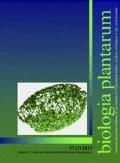Abstract
Traditionally, tetraploid Paspalum notatum was considered an obligate or a facultative apomict according to cytoembryological analyses. The degree of facultativeness was usually determined by the relative amount of mature ovules bearing aposporous or meiotic (sexual) embryo sacs, or both together. We established, through progeny tests conducted with the aid of AFLP markers, the degree of residual sexuality expressed in four selected biotypes. The results showed it to be substantially and significantly lower than predicted by previous embryological analyses for the same biotypes. Moreover, the lowest expression of residual sexuality was coincident with maximum flowering period. Seed development in facultative apomictic P. notatum shows a definite bias against meiotic embryo sacs.
Abbreviations
- AFLP:
-
amplified fragment length polymorphism
- EF:
-
end of flowering season
- FCSS:
-
flow cytometric seed screen
- m:
-
maternal
- MF:
-
stage of maximum flowering
- p:
-
paternal
References
Burson, B.L., Bennett, H.W.: Cytology, method of reproduction, and fertility of Brunswickgrass, Paspalum nicorae Parodi. — Crop Sci. 10: 184–187, 1970.
Burson, B.L., Bennett, H.W.: Chromosome numbers, microsporogenesis, and mode of reproduction of seven Paspalum species. — Crop Sci. 11: 292–292, 1971.
Burton, G.W.: The method of reproduction in common bahiagrass, Paspalum notatum. — J. amer. Soc. Agron. 40: 443–452, 1948.
Burton, G.W.: Breeding pensacola bahiagrass. Paspalum notatum: I. Method of reproduction. — Agron. J. 47: 311–314, 1955.
Burton, G.W.: A search for the origin of pensacola bahiagrass. — Econ. Bot. 21: 379–382, 1967.
Curtis, M.D., Grossniklaus, U.: Molecular control of autonomous embryo and endosperm development. — Sex. Plant Reprod. 21: 79–88, 2008.
Daurelio, L.D., Espinoza, F., Quarin, C.L., Pessino, S.C.: Genetic diversity in sexual diploids and apomictic tetraploid populations of Paspalum notatum situated in sympatry or allopatry. — Plant Syst. Evol. 244: 189–199, 2004.
Dellaporta, S.L., Wood, J., Hicks, J.B.: A plant DNA minipreparation: Version II. — Plant mol. Biol. Rep. 1: 19–21, 1983.
Espinoza, F., Urbani, M.H., Martínez, E.J., Quarin, C.L.: The breeding system of three Paspalum species with forage potential. — Trop. Grassland 35: 211–217, 2001.
Espinoza, F., Daurelio, L.D., Pessino, S.C., Valle, E.M., Quarin, C.L.: Genetic characterization of Paspalum notatum accessions by AFLP markers. — Plant Syst. Evol. 258: 147–159, 2006.
Fernandes, M.I.B.M., Barreto, I.L., Salzano, F.M.: Cytogenetic, ecologic and morphologic studies in Brazilian forms of Paspalum notatum. — Can. J. Genet. Cytol. 15: 523–531, 1973.
Gates, R.N., Quarin, C.L., Pedreira, C.G.S.: Bahiagrass. — In: Moser, L.E., Burson, B.L., Sollenberger, L.E. (ed): Warmseason (C4) Grasses. Pp 651–680. ASA, CSSA, and SSSA Publishers, Madison 2004.
Magoon, M.L., Manchanda, P.L.: A cytological study of some species in the genus Paspalum. — Indian J. Genet. Plant Breed. 21: 212–220, 1961.
Martínez, E.J., Espinoza, F., Quarin, C.L.: BIII progeny (2n + n) from apomictic Paspalum notatum obtained through early pollination. — J. Hered. 85: 295–297, 1994.
Martínez, E.J., Urbani, M.H., Quarin, C.L., Ortiz, J.P.A.: Inheritance of apospory, Paspalum notatum. — Hereditas 135: 19–25, 2001.
Matzk, F., Meister, A., Schubert, I.: An efficient screen for reproductive pathways using mature seeds of monocots and dicots. — Plant J. 21: 97–108, 2000.
Nogler, G.A.: Gametophytic apomixis. — In: Johri, B.M. (ed.): Embryology of Angiosperms. Pp. 475–518. Springer-Verlag, Berlin 1984.
Norrmann, G.A., Quarin, C.L., Burson, B.L.: Cytogenetics and reproductive behaviour of different chromosome races in six Paspalum species. — J. Hered. 80: 24–28, 1989.
Quarin, C.L.: Seasonal changes in the incidence of apomixis of diploid, triploid, and tetraploid plants of Paspalum cromyorrhizon. — Euphytica 35: 515–522, 1986.
Quarin, C.L.: The nature of apomixis and its origin in panicoid grasses. — Apomixis Newslett. 5: 8–15, 1992.
Savidan, Y.: Nature et héredité de l’apomixie chez Panicum maximum Jacq. — Ph.D. Thesis, Université de Paris-Sud, Centre d’Orsay, Paris 1982.
Savidan, Y.: Apomixis: genetics and breeding. — Plant Breed. Rev. 18: 13–86, 2000.
Siena, L.A., Sartor, M.E., Espinoza, F., Quarin, C.L., Ortiz, J.P.A.: Genetic and embryological evidences of apomixis at the diploid level of Paspalum rufum support recurrent autopolyploidization in the species. — Sex. Plant Reprod. 21: 205–215, 2008.
Stein, J., Quarin, C.L., Martínez, E.J., Pessino, S.C., Ortiz, J.P.A.: Tetraploid races of Paspalum notatum show polysomic inheritance and preferential chromosome pairing around the apospory-controlling locus. — Theor. appl. Genet. 109: 186–191, 2004.
Taskin, K.M., Turgut, K., Scott, R.J.: Apomeiotic pollen mother cell development in the apomictic Boechera species. — Biol. Plant. 53: 468–474, 2009.
Young, B.A., Sherwood, R.T., Bashaw, E.C.: Cleared-pistil and thick-sectioning techniques for detecting aposporous apomixis in grasses. — Can. J. Bot. 57: 1668–1672, 1979.
Acknowledgements
We thank Juan César Vilardi and Andrea Panseri for their technical assistance and Florencia Galdeano who managed the flow cytometer. We also thank Henry A. Fribourg and Michael Hayward for their kindly assistance concerning idiomatic English. This work was supported by Agencia Nacional de Promoción Científica y Técnica (grants PICT 13578 and PAV 137/3), Secretaría General de Ciencia y Técnica, Universidad Nacional del Nordeste and Consejo Nacional de Investigaciones Científicas y Técnicas (CONICET). Quarin and Espinoza belong to the research staff of CONICET. Rebozzio and Sartor received fellowships from CONICET.
Author information
Authors and Affiliations
Corresponding author
Rights and permissions
About this article
Cite this article
Rebozzio, R.N., Sartor, M.E., Quarin, C.L. et al. Residual sexuality and its seasonal variation in natural apomictic Paspalum notatum accessions. Biol Plant 55, 391–395 (2011). https://doi.org/10.1007/s10535-011-0062-2
Received:
Accepted:
Published:
Issue Date:
DOI: https://doi.org/10.1007/s10535-011-0062-2

